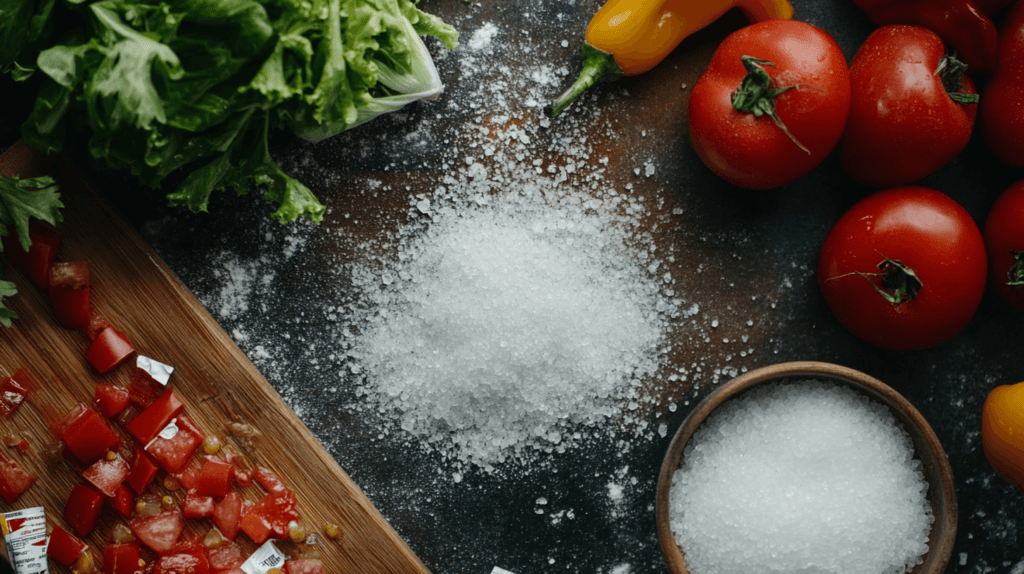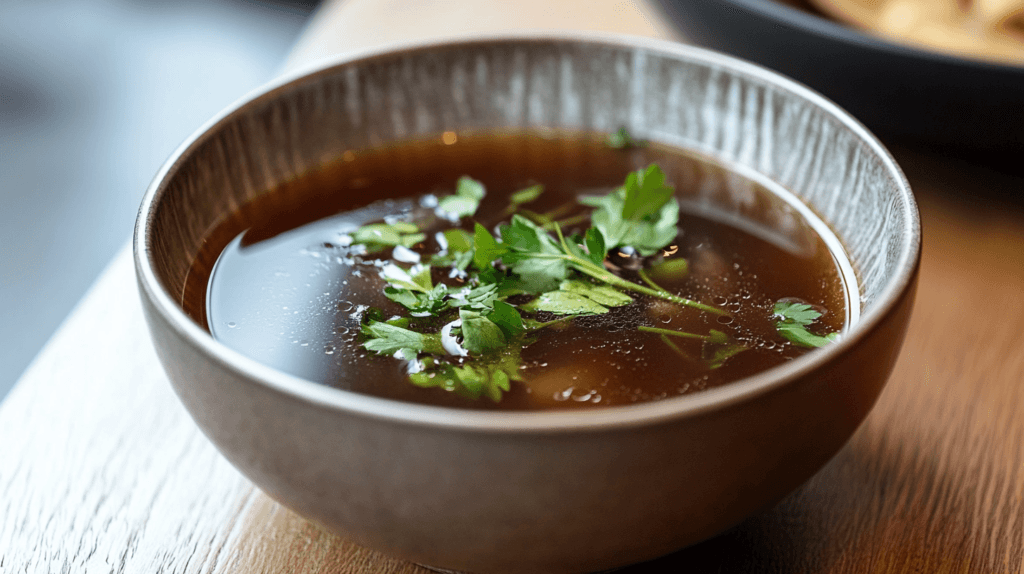Introduction
Bone broth has become a kitchen staple for its versatility, nutritional value, and deep flavor. Whether you’re sipping it as a warming drink or using it as a base for soups and stews, this nutrient-rich liquid is celebrated for its benefits. It’s packed with collagen, amino acids, and minerals that can promote joint health, improve digestion, and even enhance the skin’s elasticity.
But to achieve these benefits, you must carefully consider the ingredients you use. While bone broth thrives on simplicity, certain additions can ruin its taste, nutritional profile, or both. In this guide, we’ll explore what not to add to bone broth to ensure it stays wholesome and flavorful.
The Core Principles of Making Bone Broth
Creating a delicious and nutritious bone broth hinges on a few essential principles. These guidelines help ensure that your broth is not only flavorful but also packed with the health benefits that make it so beloved. Let’s delve deeper into the core principles of making bone broth:
1. Use High-Quality Bone Broth
The foundation of any great bone broth lies in the quality of the bones you use. Opt for bones from organic, pasture-raised animals whenever possible. These provide a cleaner flavor and are free from harmful additives or toxins that might be present in conventionally raised livestock.
- Beef Broth: Use marrow bones, knuckle bones, or oxtail for a rich, gelatinous broth.
- Chicken Broth: Go for chicken feet, wings, necks, and backs to maximize collagen content.
- Fish Broth: Utilize fish heads and carcasses from sustainably caught species for a lighter, nutrient-dense broth.
2. Simmer Bone Broth Low and Slow
Patience is key when making bone broth. The process involves extracting nutrients and flavors from the bones, which takes time.
- Cooking Time: Aim for 12–24 hours for beef broth, 6–8 hours for chicken broth, and 2–4 hours for fish broth.
- Heat Level: Keep the broth at a gentle simmer rather than a rolling boil. Boiling can cause impurities to circulate in the broth, leading to a cloudy appearance and overly intense flavor.
3. Incorporate Aromatics Wisely for Bone Broth
Aromatics like onions, carrots, and celery add depth to the flavor without overpowering the broth. These vegetables are mild and complement the natural richness of the bones.
- Preparation Tip: Chop vegetables into large chunks for easy straining later.
- Timing: Add vegetables in the final hours of cooking to prevent them from breaking down completely.
4. Add an Acidic Element to Enhance Bone Broth
A splash of vinegar or lemon juice helps extract minerals such as calcium, magnesium, and potassium from the bones into the broth. This small addition enhances the nutritional profile of your broth.
- Best Choices: Apple cider vinegar is a popular option for its mild flavor, but white vinegar or lemon juice works as well.
- Quantity: Use 1–2 tablespoons per gallon of water to avoid overpowering the flavor.
5. Balance Water to Bone Ratio
The right water-to-bone ratio ensures your broth isn’t too diluted or overly concentrated. A general guideline is to add enough water to cover the bones by about 2 inches. Too much water can result in a thin broth, while too little might make it overly strong or gelatinous.
6. Skim Impurities Regularly
As the broth simmers, impurities and foam will rise to the surface. Skimming them off helps achieve a clean and clear broth while preventing any bitter flavors.
- Pro Tip: Use a fine-mesh skimmer or a spoon to remove foam during the first hour of cooking. Afterward, the need to skim decreases as the impurities settle.
7. Avoid Over-Seasoning Bone Broth Early
Bone broth is a versatile base for soups, stews, and sauces, so it’s best to season it lightly during the cooking process. Salt and strong seasonings can be adjusted later, depending on how you plan to use the broth.
- Season Gently: A few peppercorns and a bay leaf can add subtle flavor without overpowering.
- Wait on Salt: Add salt only after the broth is fully cooked and strained.
8. Strain and Store Bone Broth Properly
Once the broth has finished cooking, strain it through a fine-mesh sieve or cheesecloth to remove bones, vegetables, and other solids. Proper storage ensures your broth remains fresh and safe to use.
- Refrigeration: Store in airtight containers in the fridge for up to 5 days.
- Freezing: Freeze in portioned sizes for up to 6 months. Use ice cube trays for convenient single servings.
9. Adjust for Desired Gelatin Content
Gelatin-rich broth is highly prized for its health benefits and rich mouthfeel. If your broth doesn’t gel when cooled, don’t worry—it still retains most of its nutrients. However, to increase gelatin content, consider adding more collagen-rich bones like chicken feet or beef knuckles.
Ingredients You Should Avoid in Bone Broth

Strongly Flavored Herbs and Spices in Bone Broth
Why Overpowering Herbs Can Ruin the Flavor
Bone broth is best enjoyed with a subtle, savory profile. Overpowering herbs like rosemary, thyme, or tarragon, especially in large quantities, can dominate the flavor. Instead of a neutral base that complements various dishes, you may end up with a broth that’s one-dimensional.
Examples of Herbs to Limit or Avoid
- Rosemary: Can give a medicinal taste.
- Sage: Overly earthy and intense.
- Tarragon: Too sweet and aromatic.
Stick to milder herbs like parsley or a small bay leaf to preserve the broth’s versatility.
Excessive Salt or Salty Ingredients in Bone Broth
The Role of Salt in Bone Broth
While a pinch of salt can enhance flavor, excessive amounts are a common mistake. Because bone broth is often reduced during cooking, salt can concentrate, leading to an overly salty and unpalatable final product.
Ingredients with Hidden Sodium
Be cautious of the following:
- Soy sauce or other salty condiments.
- Pre-seasoned bones that may already contain salt.
- Canned vegetables that are often preserved with salt.
Add salt sparingly at the end of cooking to control the final flavor.
Highly Processed or Artificial Ingredients in Bone Broth
Avoiding Artificial Flavor Enhancers
Processed flavor enhancers like bouillon cubes, MSG, or prepackaged seasoning blends may seem convenient but undermine the broth’s natural quality. They add unnecessary artificial elements and can overpower the clean taste of the broth.
Why Processed Ingredients Are a No-Go
Bone broth is cherished for its health benefits, and using highly processed ingredients defeats the purpose. Focus on whole, fresh foods to keep the broth nutritious and additive-free.
Dairy and Creamy Additives
How Dairy Can Affect the Broth’s Purpose
Bone broth is traditionally dairy-free, and for a good reason. Adding milk, cream, or cheese can create an unappealing texture and dilute the gelatinous quality that makes bone broth so valuable for joint health.
When to Consider Dairy-Free Alternatives
If you want a creamier texture, consider blending the broth with cooked vegetables like cauliflower or potato after cooking. This approach keeps the broth nutrient-rich and lactose-free.
Sugary Ingredients or Sweeteners in Bone Broth
Why Sugar Has No Place in Bone Broth
Bone broth is meant to be savory, and adding sugar or sweeteners can disrupt its intended flavor profile. This mistake often happens when people experiment with sauces or marinades that contain hidden sugars.
Hidden Sources of Sweeteners to Avoid
- Barbecue sauce or other sugary condiments.
- Ketchup or tomato-based products with added sugar.
- Honey or syrup, unless used sparingly for specific recipes.
Overly Fatty Ingredients in Bone Broth
Managing Fat Content for Healthier Broth
Fat is a natural part of bone broth, but too much can make it greasy and heavy. While some fat adds richness, excessive amounts can overwhelm the palate and mask other flavors.
How to Skim Excess Fat Effectively
Once your broth cools, the fat will rise to the surface. Skimming it off with a spoon ensures a cleaner, more enjoyable broth.
Non-Food Ingredients or Unsafe Additions
Avoiding Additives Like Vinegar in Excess
While a splash of vinegar helps extract minerals from bones, using too much can make the broth overly tangy or sour. Stick to one to two tablespoons per pot.
Potential Health Risks of Unsafe Items
Never add non-edible items or experiment with unfamiliar substances in your broth. Safety and flavor should always be the top priorities.
Tips for the Perfect Bone Broth Flavor

Crafting the perfect bone broth requires more than just tossing bones into a pot with water. To achieve a balanced, rich, and flavorful broth, careful attention to detail is essential. Here are some expert tips to elevate the flavor of your bone broth:
1. Roast the Bones for Depth of Flavor
Roasting bones before simmering them can significantly enhance the flavor of your broth. This step caramelizes the natural sugars in the bones, creating a deeper, richer taste.
- How to Roast: Arrange bones on a baking sheet and roast at 400°F (200°C) for 30–45 minutes, turning once for even browning.
- Pro Tip: Include vegetables like onions, carrots, and celery in the roasting process for additional flavor complexity.
2. Select the Right Aromatics
Aromatic vegetables and herbs are key to building a well-rounded broth flavor. The classic trio—onions, carrots, and celery—adds subtle sweetness and balance.
- Suggested Additions: A few garlic cloves, leeks, or a sprig of parsley can elevate the flavor.
- Avoid Overpowering Herbs: Limit strong herbs like rosemary or sage to prevent dominating the flavor profile.
3. Incorporate a Balanced Acidic Element
Adding an acidic component, such as apple cider vinegar or lemon juice, enhances the extraction of minerals from the bones. However, moderation is key to avoiding an overly tangy broth.
- Quantity: 1–2 tablespoons per gallon of water.
- Timing: Add at the start of simmering to allow it to work throughout the cooking process.
4. Simmer, Don’t Boil
For a broth that is clean and free of unwanted bitterness, maintain a gentle simmer rather than a rapid boil. High heat can break down ingredients too quickly, resulting in cloudy broth and overly intense flavors.
- Ideal Temperature: Keep the heat low, with occasional gentle bubbling on the surface.
- Duration: Beef and pork broths benefit from 12–24 hours of simmering, while chicken broth takes 6–8 hours.
5. Use a Proper Water-to-Bone Ratio
Too much water can dilute the broth, while too little can lead to overly concentrated flavors. For a balanced result, ensure the water covers the bones by about 2 inches.
- Check Levels: Add water as needed during long cooking times to prevent bones from becoming exposed.
6. Add Vegetables at the Right Time
While bones benefit from long simmering, vegetables can break down and lose flavor if cooked too long. Add them during the last few hours of cooking to preserve their freshness.
- Pro Tip: Use large chunks to make straining easier.
- Suggested Vegetables: Onion halves, peeled carrots, and celery stalks.
7. Skim Regularly for Clean Flavor
During the first few hours of simmering, impurities and foam will rise to the surface. Regularly skimming these off ensures a clean-tasting broth and removes bitterness.
- How to Skim: Use a fine-mesh skimmer or a large spoon to remove foam.
- Frequency: Focus on skimming during the first hour, then less frequently as cooking progresses.
8. Season Sparingly
Bone broth is often used as a base for other dishes, so it’s wise to season it lightly during cooking. Too much salt or spice can limit its versatility.
- Best Approach: Add only a pinch of salt or a few peppercorns during cooking. Adjust seasoning once the broth is finished.
9. Control Fat Content
Fat adds richness to the broth, but too much can make it greasy. After cooking, allow the broth to cool and skim off the solidified fat layer for a cleaner, more balanced flavor.
- Pro Tip: Use a ladle or a fat separator to remove excess fat without discarding any broth.
- Desired Balance: Retain a thin layer of fat for flavor and mouthfeel.
10. Strain and Store Properly
Once the broth is finished, strain it through a fine-mesh sieve or cheesecloth to remove solids and ensure a smooth texture.
- Storage Tip: Divide the broth into portions and refrigerate for up to 5 days or freeze for up to 6 months.
- Avoid Stale Flavor: Always store in airtight containers to prevent absorption of fridge odors.
11. Enhance with Finishing Touches
If your broth needs a little extra flair, consider adding small finishing touches just before serving.
- Options to Try: A squeeze of fresh lemon juice, a sprinkle of sea salt, or a few drops of soy sauce for umami.
- Herb Garnishes: Fresh parsley, cilantro, or a sprig of thyme can add a burst of freshness.
12. Experiment with Variations
Once you’ve mastered the basics, try customizing your broth with unique ingredients like mushrooms, seaweed, or ginger for additional flavor dimensions. These can complement specific cuisines or dishes.
- For Asian-Inspired Broth: Add a piece of ginger and a few star anise pods.
- For Mediterranean Dishes: Try bay leaves and fennel seeds.
FAQs
Can I Add Leftover Vegetables to Bone Broth?
Yes, you can add leftover vegetables to your bone broth, but avoid vegetables with strong or overpowering flavors like cabbage or broccoli, which can make the broth bitter. Instead, opt for neutral vegetables such as carrots, celery, and onions to enhance the flavor. For more creative ways to use vegetables, explore our leftover rotisserie chicken recipes that pair well with bone broth.
Is It Okay to Add Citrus to Bone Broth?
Adding a small amount of citrus, like a splash of lemon juice, can brighten the broth’s flavor. However, excessive citrus can make the broth overly acidic, masking its earthy tones. If you’re looking for a tangy soup alternative, check out our sinigang recipe, which balances sour and savory flavors beautifully.
Should Bone Broth Have an Acidic Element?
Yes, adding an acidic element like vinegar or lemon juice helps extract minerals from the bones into the broth. However, limit it to one or two tablespoons per pot to avoid an overly tangy flavor. For tips on managing acidity in other dishes, read our guide on how to make sinigang more sour.
Can I Add Alcohol to Bone Broth for Flavor?
Alcohol, such as wine or sherry, can add depth to bone broth, but it should be used sparingly. A small splash is enough to enhance the aroma without overshadowing the natural flavors. Make sure to simmer it thoroughly to cook off the alcohol content.
What Are the Best Bones to Use?
The best bones for broth include marrow bones, knuckle bones, and oxtail. Chicken feet, wings, and necks are also excellent choices for poultry-based broth. These bones are rich in collagen, which contributes to the broth’s gelatinous texture and nutritional value.
Can I Freeze Bone Broth with Vegetables?
Although you can freeze bone broth with vegetables, it’s better to strain the broth first. Vegetables often lose their texture and flavor during freezing and reheating. For advice on freezing food properly, see our article on how to freeze leftover rotisserie chicken.
Conclusion
Bone broth is a culinary and nutritional treasure, but only when prepared thoughtfully. By avoiding overpowering herbs, excessive salt, artificial ingredients, and unsuitable additives, you can ensure a clean, flavorful, and nutrient-dense broth. Remember to keep your ingredient list simple and balanced, allowing the natural essence of the broth to shine through.
Whether you’re sipping it alone or using it as a base for hearty dishes, follow the guidelines here to craft the perfect broth every time. To expand your kitchen repertoire, explore more recipes and cooking techniques at Journey Recipes.

